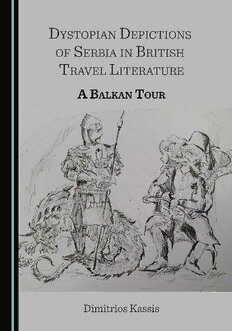Table Of ContentDystopian Depictions
of Serbia in British
Travel Literature
Dystopian Depictions
of Serbia in British
Travel Literature
:
A Balkan Tour
By
Dimitrios Kassis
Dystopian Depictions of Serbia in British Travel Literature:
A Balkan Tour
By Dimitrios Kassis
This book first published 2022
Cambridge Scholars Publishing
Lady Stephenson Library, Newcastle upon Tyne, NE6 2PA, UK
British Library Cataloguing in Publication Data
A catalogue record for this book is available from the British Library
Copyright © 2022 by Dimitrios Kassis
All rights for this book reserved. No part of this book may be reproduced,
stored in a retrieval system, or transmitted, in any form or by any means,
electronic, mechanical, photocopying, recording or otherwise, without
the prior permission of the copyright owner.
ISBN (10): 1-5275-7655-8
ISBN (13): 978-1-5275-7655-1
TABLE OF CONTENTS
Acknowledgements ................................................................................... vii
Abstract ...................................................................................................... ix
Introduction ................................................................................................. 1
Chapter One ............................................................................................... 15
Wortley Montagu, Lady Merry. The Letters of Lady M. W. Montagu
during the Embassy to Constantinople,1716–1718
Chapter Two .............................................................................................. 21
Hervé, Francis. A Residence in Greece and Turkey, with Notes of the
Journey through Bulgaria, Servia, Hungary, and the Balkan
Chapter Three ............................................................................................ 27
Boileau Elliott, Charles. Travels in the Three Great Empires of Austria,
Russia and Turkey
Chapter Four .............................................................................................. 33
Turnbull, Peter Evan. Austria: Social and Political Condition
Chapter Five .............................................................................................. 41
Spencer, Edmund. Travels in European Turkey in 1850
Chapter Six ................................................................................................ 61
Beaufort Smythe, Emily Ann (Viscountess Strangford). The Eastern
Shores of the Adriatic in 1863
Chapter Seven ............................................................................................ 73
Trevor, Roy. My Balkan Tour, An Account of Some Journeyings and
Adventures in the Near East, Together with a Descriptive and Historical
Account of Bosnia and Herzegovina, Dalmatia, Croatia and the Kingdom
of Montenegro
vi Table of Contents
Conclusion ................................................................................................. 89
Bibliography .............................................................................................. 93
ACKNOWLEDGEMENTS
This book is dedicated to my beloved grandmother, whose memory has
left a lingering effect on our family.
I also with to express my gratitude to my Serbian teacher Jelena
(cid:39)(cid:77)(cid:82)(cid:85)(cid:71)(cid:77)(cid:72)(cid:89)(cid:76)(cid:252) for her vast contribution to my better understanding of Serbian
language and culture.
ABSTRACT
Without any doubt, one of the European regions that has never ceased
to trouble the Westerner traveller was the Balkan Peninsula with its
complex political and national conditions. Divided between the West and
the East, Serbia functioned as a terra incognita within the British travel
canon, that served as the transit point to the Ottoman Empire or the Old
Grecian world. At a time when Anglo-Saxonism occupied a prevalent
position in the British political discourse, the Balkan peninsula came to
epitomise all the negative qualities of the Orient that British travellers
were anxious to apply to alien countries that were far removed from the
nation-building agenda of the Empire. Thus, classified as the fringe of the
Orient, Serbia was persistently depicted as a politically unstable region,
inhabited by primitive ethnic groups that could possibly threat the
viability of the British imperialist interests in European Turkey. In the
light of the Serbian national struggle to promote the idea of a South-
Slavic Union or forge an identity against the Austrian and the Ottoman
Empires, some British travellers undertook a journey to all the Balkan
states where Serbians formed the majority of the population to demonise
the War of Liberation of the Balkan states against the Ottoman yoke,
treating it as visible evidence of Russian Expansionism. Inevitably, the
dystopian view of Serbia as a primitive, savage Other was linked to the
pan-Slavic movement that emerged during the 1850s in the Balkan
nations as a response to their long subjugation to foreign powers.
This book concentrates on dystopian British imagology on Serbia as a
travel destination, including travel accounts produced from 1717 until
1911, a year prior to the outbreak of the First World War. The travel texts
incorporated into this volume shed light on all the conceptualisations of
the Balkans, addressing the sociopolitical conditions that sparked the
national awakening of Serbia.

